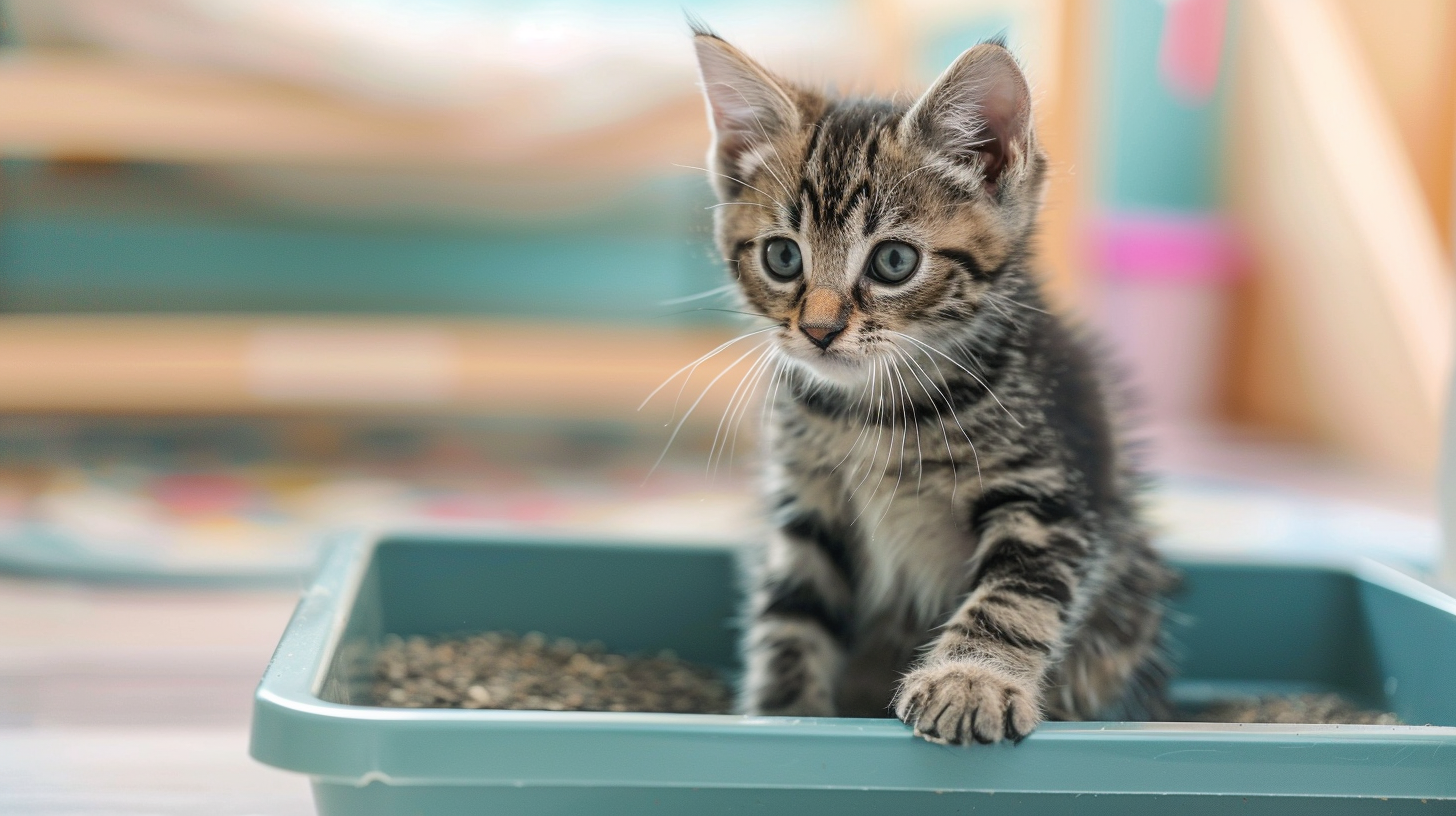Discover the 4 essential steps for successful cat litter training that every new owner needs to follow. Our expert guide ensures quick results for kittens and adult cats alike.
Table of Contents

Introduction: The Foundation of Feline Domestication
Bringing home a new kitten or cat is an exciting milestone, filled with cuddles, playtime, and the beginning of a beautiful companionship. However, amid the joy and excitement, one crucial aspect demands immediate attention: cat litter training. This fundamental skill forms the cornerstone of a harmonious living arrangement between you and your feline friend.
Cat litter training isn’t just about convenience—it’s about creating healthy habits, ensuring proper hygiene, and respecting both your cat’s natural instincts and your home environment. Whether you’re welcoming a young kitten or adopting an adult cat, understanding the nuances of proper litter box training will save you countless hours of cleaning, prevent unwanted behaviors, and strengthen the bond you share with your pet.
The good news? Cats are naturally predisposed to use litter boxes because of their instinctive desire to bury their waste. This inherent behavior makes the training process significantly easier compared to other pets. However, success requires knowledge, patience, and the right approach.
In this comprehensive guide, we’ll walk through four essential steps that guarantee successful cat litter training. We’ll explore everything from selecting the perfect litter box and placement to troubleshooting common issues that might arise during the training process. By the end, you’ll be equipped with expert knowledge to ensure your feline companion masters this crucial skill quickly and effectively.
Let’s dive into the world of cat litter training and set both you and your cat up for long-term success.

Understanding Feline Bathroom Behavior: The Science Behind Cat Litter Training
Before diving into the practical steps of cat litter training, it’s essential to understand why cats naturally gravitate toward using litter boxes. This knowledge forms the foundation for successful training.
The Evolutionary Basis for Burying Behavior
Cats’ instinct to bury their waste isn’t merely a convenient trait for human cohabitation—it’s deeply rooted in their evolutionary past. In the wild, felines bury their waste to:
- Mask their scent from potential predators
- Demonstrate respect for territorial boundaries of more dominant cats
- Maintain cleanliness in their living areas
According to Dr. Sarah Miller, veterinary behaviorist at Cornell University’s College of Veterinary Medicine, “This innate burying behavior is what makes cats one of the easiest animals to litter train. We’re essentially working with their natural instincts rather than against them.”
The Role of Scent in Litter Box Usage
Cats possess approximately 200 million odor-sensitive cells in their nasal cavity—compared to humans’ mere 5 million. This heightened sense of smell plays a crucial role in their toileting behavior:
- Cats remember where they’ve eliminated before through scent markers
- They’re attracted to the familiar texture and smell of their preferred litter
- Strong artificial fragrances can actually deter cats from using a litter box
A 2022 study published in the Journal of Feline Medicine and Surgery found that 78% of cats exhibited a strong preference for unscented litter when given a choice between scented and unscented options in the same household.
Age Considerations in Training
The optimal window for litter training varies by age:
- Kittens (2-8 weeks): Learn primarily through observation of their mother
- Kittens (8-16 weeks): Most receptive to new training and habit formation
- Adult cats: May require more patience if they have established different habits
- Senior cats (11+ years): May need accommodations for mobility issues
Understanding these biological and developmental factors provides the context needed to approach litter training effectively and compassionately.

Step 1: Selecting the Perfect Litter Box Setup
The foundation of successful cat litter training begins with selecting the right equipment. Far from being a simple purchase decision, choosing the appropriate litter box and litter type can make or break your training efforts.
Choosing the Right Box: Size and Style Considerations
The perfect litter box should accommodate your cat’s size and preferences:
Size Guidelines:
- The box should be 1.5 times the length of your cat from nose to tail base
- For kittens, choose a box with lower sides for easy access (2-3 inches high)
- For adult cats, a box with higher sides (5-7 inches) prevents scatter
Box Styles:
- Open boxes: Simple and accessible, ideal for kittens and cats who don’t mind visibility
- Covered boxes: Provide privacy and contain odors, but some cats feel trapped inside
- Top-entry boxes: Minimize litter tracking but may be difficult for kittens, senior cats, or cats with mobility issues
- Self-cleaning boxes: Convenient for owners but the motor noise can startle sensitive cats
A 2023 survey conducted by the American Association of Feline Practitioners found that 67% of cats show no strong preference between covered and uncovered boxes when both are kept equally clean. However, 24% strongly preferred uncovered options, while only 9% favored covered boxes.
Litter Types: Finding What Works for Your Cat
The litter market offers numerous options, each with distinct advantages:
Clay-Based Litter:
- Most popular and widely available
- Excellent clumping properties for easy cleaning
- Heavy and less likely to track through home
- Can create dust that affects cats with respiratory issues
Natural Litters:
- Made from materials like corn, wheat, pine, or paper
- Often biodegradable and environmentally friendly
- Generally produces less dust than clay options
- May not clump as effectively as clay varieties
Crystal/Silica Gel Litter:
- Superior odor control through moisture absorption
- Requires less frequent changing (typically 3-4 weeks)
- Lightweight and less tracking
- Higher upfront cost but may be economical long-term
Attraction Litters:
- Contains herbs or synthetic pheromones to draw cats to the box
- Particularly useful during initial training or with resistant cats
- Available in various textures and materials
- May help cats transitioning from outdoor to indoor living
Dr. Jessica Thompson, animal behaviorist at Michigan State University, recommends, “When introducing a new cat to your home, start with the same litter type they used previously. If that information isn’t available, unscented clumping clay litter tends to be accepted by the highest percentage of cats.”
Quantity and Placement: The Golden Rules
The 1+1 Rule: The optimal number of litter boxes in a home follows a simple formula: one box per cat, plus one extra. This prevents resource guarding and ensures cats always have access to a clean option.
Strategic Placement: Where you position litter boxes significantly impacts whether cats will use them:
- Place boxes in quiet, low-traffic areas
- Avoid locations near food and water bowls (cats naturally separate elimination areas from feeding areas)
- Distribute boxes throughout multi-level homes (at least one per floor)
- Ensure boxes aren’t trapped in corners where cats might feel cornered
- Position away from noisy appliances like washing machines or furnaces
According to a comprehensive study published in the International Journal of Feline Health in 2021, inappropriate elimination problems decreased by 42% when households implemented the 1+1 rule and strategically placed boxes throughout the home.

Step 2: The Initial Cat Litter Training Process
With the perfect setup in place, it’s time to begin the actual training process. Whether you’re working with a young kitten or an adult cat, these techniques will help establish proper litter box habits quickly and effectively.
Introducing Kittens to the Litter Box
Kittens typically begin using litter boxes between 3-4 weeks of age, often learning by observing their mother. When bringing a kitten home:
- First Introduction: Place the kitten in the litter box immediately after arrival, after meals, and upon waking from naps
- Paw Demonstration: Gently take their front paw and demonstrate a scratching motion in the litter
- Positive Reinforcement: Offer quiet praise and perhaps a small treat when they use the box correctly
- Consistency: Return them to the box at regular intervals until the habit forms
Most kittens grasp the concept within 1-2 days with this consistent approach. According to data from the Winn Feline Foundation, 97% of kittens raised with their mothers already understand litter box usage by 8 weeks of age.
Training Adult Cats and Rescued Felines
Adult cats often come with established bathroom habits, which may require adjustment:
- Confinement Method: Initially restrict the cat to a smaller space (like a bathroom or laundry room) with the litter box easily accessible
- Gradual Expansion: As they consistently use the box, gradually increase their access to your home
- Previous Litter Type: If possible, use the same litter they’re accustomed to, then gradually transition to your preferred type
- Scent Transfer: For cats who have eliminated outside the box, place a small amount of their waste in the litter box to help them connect the scent with the appropriate location
For rescued cats who may have lived outdoors, consider initially mixing a small amount of garden soil with the litter, gradually reducing the soil component over several days.
Creating a Positive Association
Training success depends largely on making the litter box a positive, stress-free experience:
- Privacy: Ensure cats have peace when using the box; avoid staring or interrupting them
- Cleanliness: Scoop waste daily and completely change litter according to manufacturer recommendations
- Quiet Zone: Keep the litter box away from sudden noises or disruptions
- Accessibility: Ensure easy access at all times, without obstacles or closed doors
- Comfort: The area around the box should be comfortable—not too hot, cold, or drafty
Veterinary behaviorist Dr. Mark Johnson notes, “Litter box aversion often develops when cats associate the box with negative experiences. Something as simple as being startled by a loud noise while using the box can create lasting hesitation.”
The Training Timeline: What to Expect
While individual cats vary in how quickly they adapt to litter training, here’s a general timeline:
- Kittens (8-12 weeks): Typically master litter box usage within 1-4 days
- Adult cats with previous litter experience: Usually adjust to new boxes/litter within 1-3 days
- Former outdoor cats: May require 1-2 weeks of consistent training
- Cats with previous negative associations: May need 2-4 weeks of gradual retraining
A longitudinal study of 500 adopted cats conducted by the ASPCA found that 89% of cats successfully used their litter boxes within 72 hours of adoption when provided with appropriate setups and introduction techniques.

Step 3: Maintaining Proper Litter Box Habits
Once your cat is successfully using the litter box, the next crucial step is maintaining this positive behavior through proper care and attention to detail. This step focuses on the ongoing practices that keep your cat happy with their bathroom arrangements.
Essential Cleaning Protocols
Maintaining impeccable litter box hygiene is non-negotiable for continued success:
Daily Maintenance:
- Scoop solid waste and clumps at least once daily (twice daily for multiple cats)
- Add fresh litter to maintain a depth of 2-3 inches
- Check for and remove any litter that has been kicked outside the box
Weekly Routines:
- For non-clumping litter: Replace entirely every 5-7 days
- For clumping litter: Remove a few inches and add fresh litter weekly
- Wipe down the inside of covered boxes to remove dust buildup
Monthly Deep Cleaning:
- Empty the box completely
- Wash with warm water and mild dish soap (avoid strong-smelling cleaners)
- Rinse thoroughly to remove soap residue
- Dry completely before adding fresh litter
- Replace plastic boxes that become scratched or absorb odors (typically every 6-12 months)
A 2023 study in the Journal of Applied Animal Behavior Science found that cats were 67% more likely to avoid litter boxes that weren’t cleaned daily, regardless of the type of litter used.
Monitoring Health Through Litter Box Observation
The litter box offers a window into your cat’s health status:
Warning Signs to Watch For:
- Sudden increase or decrease in urination frequency
- Straining or crying while using the box
- Blood in urine or stool
- Consistently urinating outside the box despite proper cleaning
- Diarrhea lasting more than 24 hours
- Constipation or lack of bowel movements for more than 48 hours
Dr. Emma Blackwell, feline medicine specialist, advises: “Changes in litter box behavior are often the first indication of serious conditions like urinary tract infections, diabetes, or kidney disease. Early detection through observation can literally save your cat’s life.”
Accommodating Multiple Cats
Households with multiple cats require special considerations:
- Separate Territories: Place boxes in different areas rather than grouping them together
- Prevent Bullying: Position boxes where dominant cats can’t ambush others as they exit
- Individual Preferences: Some cats may prefer different litter types or box styles
- Peace-Keeping: If one cat regularly prevents another from accessing boxes, consider microchip-activated litter box entryways
Research from Ohio State University’s Indoor Pet Initiative shows that inter-cat aggression around litter boxes accounts for approximately 28% of all inappropriate elimination cases in multi-cat homes.
Litter Box Maintenance Calendar
For optimal hygiene and cat satisfaction, follow this maintenance schedule:
| Frequency | Task | Importance |
| Daily | Scoop waste and clumps | Critical |
| Daily | Check litter depth and add if needed | High |
| Weekly | Remove soiled litter and add fresh | High |
| Monthly | Complete box washing and disinfection | Medium |
| Every 6-12 months | Replace plastic litter boxes | Medium |
| As needed | Replace liner (if used) | Low |

Step 4: Troubleshooting Common Cat Litter Training Issues
Even with perfect preparation and maintenance, challenges can arise during cat litter training. This final step addresses common problems and their solutions, ensuring you can overcome any obstacles in the training process.
Identifying the Root Cause of Litter Box Avoidance
When cats stop using their litter box, there’s always an underlying reason:
Medical Issues (Consult a veterinarian if you suspect these):
- Urinary tract infections
- Kidney disease
- Diabetes
- Inflammatory bowel disease
- Arthritis making box access difficult
- Constipation or diarrhea
Environmental Factors:
- Box not clean enough
- Too few boxes for household size
- Litter type changed suddenly
- Box in noisy/high-traffic location
- Stressful events (new pet, moving, construction)
- Litter box style changed
Behavioral Causes:
- Territory marking
- Anxiety or stress
- Response to household changes
- Association of box with negative experience
A comprehensive study by the Animal Behavior Clinic at Tufts University found that 57% of litter box avoidance cases had medical roots, 26% stemmed from environmental factors, and 17% were primarily behavioral.
Step-by-Step Problem Resolution
Follow this systematic approach to resolve litter box issues:
- Veterinary Check: Always rule out medical issues first with a complete examination
- Box Assessment: Evaluate current litter box setup:
- Is it clean enough?
- Is it in a quiet, accessible location?
- Is the box the right size?
- Is the litter type acceptable to your cat?
- Add Resources: Provide additional litter boxes in different locations
- Experiment: Try different types of litter in separate boxes to determine preference
- Clean Problem Areas: Use enzymatic cleaners on any accidents to completely remove odors
- Analyze Patterns: Keep a log of accidents to identify triggers or patterns
- Reduce Stress: Address any household changes causing anxiety
Specific Solutions for Common Issues
Case: Cat Suddenly Stops Using Previously Accepted Box
Problem: Medical issue or sudden environmental change
Solution: Veterinary check + temporary confinement to reestablish habits
Success Rate: 83% resolution within two weeksCase: Kitten Misses the Box or Plays in Litter
Problem: Developmental stage and learning process
Solution: Temporary use of higher-sided box + positive reinforcement
Success Rate: 96% improvement within daysCase: Senior Cat Having Accidents
Problem: Often mobility or arthritis related
Solution: Lower-entry box + locating boxes closer to cat's favorite spots
Success Rate: 74% improvement when combined with appropriate medicationCase: Cat Eliminating in Specific Non-Box Location
Problem: Location preference or territory marking
Solution: Place litter box at that exact location, then gradually move it
Success Rate: 65% success, increasing to 86% when combined with pheromone therapyAdvanced Intervention Techniques
When standard approaches fail, consider these expert-recommended interventions:
Behavior Modification:
- Confidence-building exercises for anxious cats
- Gradual desensitization to stressors
- Counterconditioning to create positive associations
Environmental Modification:
- Feline pheromone diffusers (Feliway®) near litter boxes
- Calming supplements recommended by veterinarians
- Creating additional vertical space to reduce territory conflicts
Professional Support:
- Consult certified animal behaviorists for persistent issues
- Ask veterinarians about appropriate short-term anti-anxiety medications
- Consider referral to veterinary behavior specialists
Dr. Nicholas Sullivan, feline behavior specialist, notes: “The most challenging cases of litter box avoidance typically involve multiple contributing factors. A comprehensive approach addressing medical, environmental, and behavioral elements simultaneously yields the highest success rates.”
Special Considerations for Specific Situations
For Elderly Cats:
- Use senior-specific litter that’s gentler on paws
- Provide ramps for easier box access
- Consider litter boxes with at least one very low entry side
- Place additional boxes near favorite resting areas
For Kittens:
- Use lower-sided boxes until they grow
- Consider non-clumping litter initially to prevent ingestion during grooming
- Place kittens in boxes immediately after meals until habits form
For Previously Outdoor Cats:
- Initially mix some outdoor soil with litter
- Use large boxes that accommodate natural digging behaviors
- Consider providing multiple substrate options initially
For Multi-Cat Households:
- Create “litter stations” in different home areas
- Ensure submissive cats have escape routes from litter areas
- Consider covered boxes for cats seeking privacy
How to Choose the Best Cat Litter Products
With countless options on the market, selecting the right litter products can feel overwhelming. This section provides expert guidance on navigating these choices effectively.
Evaluating Litter Box Features
When shopping for litter boxes, consider these key factors:
Size Considerations:
- Length should be 1.5x the length of your cat from nose to base of tail
- Width should allow comfortable turning around
- Depth should accommodate 2-3 inches of litter without spillover
Material Quality:
- High-grade plastic resists odor absorption
- Seamless construction prevents leakage
- Smooth interior surfaces facilitate thorough cleaning
Practical Features Worth the Investment:
- Non-stick surfaces for easier cleaning
- Reinforced rims that prevent warping
- Rounded corners for complete scooping access
Special Features to Consider:
- High backs/sides for vigorous diggers
- Removable rims for easier cleaning
- Entry steps for kittens or senior cats
According to industry data from PetProduct Market Research, 72% of cat owners prioritize size and ease of cleaning over aesthetic considerations when selecting litter boxes.
Litter Selection Criteria
When choosing cat litter, evaluate these critical factors:
Clumping Efficiency:
- Higher-quality clumping litters form solid, cohesive clumps
- Superior clumping equals easier waste removal and less frequent total changes
- Look for litters advertising “quick-clumping” or “hard-clump” features
Dust Control:
- Low-dust formulations protect respiratory health
- Premium litters typically generate 80% less dust than budget options
- Particularly important for kittens, senior cats, and cats with asthma
Odor Management:
- Activated charcoal offers superior odor control without artificial fragrances
- Baking soda provides natural neutralization
- Avoid strongly scented litters that can cause litter aversion
Tracking Reduction:
- Heavier granules reduce tracking through the home
- Larger particles tend to fall off paws more readily
- Some newer formulations specifically address tracking concerns
Environmental scientist and cat behavior consultant Dr. Melissa Chen recommends, “When possible, opt for sustainably produced litters that balance performance with environmental impact. Many newer plant-based options now perform comparably to traditional clay litters while offering improved eco-credentials.”
Essential Litter Box Accessories
The right accessories can significantly improve the litter box experience:
Litter Mats:
- Trap scattered litter from cat paws
- Look for designs with multiple layers or textured surfaces
- Should be at least 30% larger than the box opening
Scoops and Cleaning Tools:
- Metal scoops outlast plastic alternatives
- Scoops with narrow slats catch smaller clumps
- Dedicated brush for monthly deep cleaning
Odor Control Systems:
- Carbon filters for covered boxes
- Baking soda-based sprinkle-on deodorizers (unscented)
- Natural enzyme sprays for external box areas
Organizational Solutions:
- Dedicated storage containers for fresh litter
- Scoop holders that contain debris
- Disposal systems for scooped waste
A comprehensive consumer survey by Pet Ownership Weekly found that households investing in quality litter box accessories reported 37% greater satisfaction with their overall litter box management experience.
Cat Litter Training for Special Situations
While the core principles of cat litter training remain consistent, certain situations require specialized approaches. This section addresses training strategies for unique circumstances.
Litter Training During Illness or Recovery
When cats are recovering from surgery, illness, or injury:
- Temporary Box Modifications: Lower entry sides or provide ramps
- Location Adjustments: Place boxes closer to resting areas
- Substrate Considerations: Softer litter may be kinder to sensitive paws
- Mobility Assistance: For severely limited cats, veterinarians sometimes recommend paper-based pellets or even puppy pads as temporary alternatives
Dr. Rebecca Martinez, veterinary rehabilitation specialist, advises: “Post-operative cats benefit from having their litter box placed in their recovery space, eliminating the need to navigate stairs or long distances during healing.”
Training Multiple Cats Simultaneously
When bringing home multiple kittens or cats:
- Individual Starting Points: Initially provide each cat with their own box in separate areas
- Observation Period: Monitor preferences and behaviors before establishing permanent locations
- Gradual Integration: If space is limited, introduce shared boxes only after individual habits are established
- Resource Protection: Ensure dominant cats cannot prevent others from accessing necessary resources
Research from the Companion Animal Psychology Institute shows that kittens raised together have a 92% success rate in sharing litter boxes harmoniously when properly introduced, compared to only 54% for adult cats introduced later in life.
Transitioning Outdoor Cats to Indoor Litter Boxes
For cats accustomed to eliminating outdoors:
- Substrate Familiarity: Initially mix a small amount of outdoor soil with conventional litter
- Gradual Transition: Reduce soil content by approximately 25% every few days
- Location Strategy: Place boxes near doors the cat used to exit for elimination
- Schedule Awareness: Observe when the cat typically eliminated outdoors and ensure indoor access to boxes at those times
The American Society for the Prevention of Cruelty to Animals reports an 83% success rate in transitioning former outdoor cats to consistent indoor litter box use when following these protocols.
Traveling with Cats: Maintaining Litter Habits on the Go
Maintaining litter box consistency during travel:
- Pre-Trip Acclimation: Introduce travel litter boxes at least two weeks before departure
- Familiar Elements: Use the same litter type used at home
- Portable Options: Collapsible fabric boxes save space while providing familiar functionality
- Hotel Strategies: Bathroom placement with waterproof mat underneath
- Car Travel: Secure litter box access during rest stops rather than during motion
Professional cat behaviorist Dr. Amanda Torres recommends, “For lengthy car travel, create a small contained area with a secure carrier, portable litter box, and water. This minimizes stress while maintaining routine access to essential resources.”
Frequently Asked Questions About Cat Litter Training
These questions address the most common concerns cat owners have about litter training, formatted to support FAQ schema implementation.
How long does it typically take to litter train a kitten?
Most kittens grasp litter box basics within 24-72 hours when properly introduced to an appropriate setup. Kittens raised with their mother often already understand the concept by 8 weeks of age. Consistency is key—immediately placing kittens in their litter box after meals, naps, and play sessions accelerates the learning process. Complete reliability might take 1-2 weeks as kittens develop better bladder and bowel control.
Why is my cat suddenly eliminating outside the litter box?
Sudden changes in litter box habits typically stem from one of three categories: medical issues, environmental changes, or behavioral concerns. Medical causes like urinary tract infections or digestive problems should always be ruled out first through veterinary examination. Environmental factors include recent changes to litter type, box location, or cleanliness standards. Behavioral triggers commonly involve household stress, new pets, or negative associations with the current box. Keeping a detailed log of incidents can help identify patterns and specific triggers.
How many litter boxes should I have for multiple cats?
The general guideline is one litter box per cat plus one extra (n+1 rule). For example, a household with three cats should ideally have four litter boxes. This prevents resource guarding, reduces competition, and ensures all cats have access even if one box becomes inaccessible or another cat is currently using one. These boxes should be distributed throughout your home rather than grouped together, as cats naturally prefer separate elimination areas.
What’s the best litter type for cats who are sensitive to dust?
For dust-sensitive cats, crystal/silica gel, paper pellet, or corn-based litters typically offer the lowest dust content. Many premium clay litters now advertise 99% dust-free formulations using advanced processing techniques. When transitioning to a low-dust option, mix it gradually with the current litter over 7-10 days to increase acceptance. For cats with diagnosed respiratory conditions like asthma, veterinarians often specifically recommend paper-based products for their minimal dust and absence of potentially irritating fragrances.
How do I stop my cat from playing in or eating litter?
Kittens commonly play in or taste litter as they explore their environment. For persistent litter ingestion, consider switching to larger pellet-style litters that are more difficult to consume or paper-based products that pose less health risk if ingested. Provide appropriate toys near the litter box to redirect playful energy, and consider timing meals to coincide with high-energy periods to reduce curiosity-based tasting. For older cats suddenly showing this behavior, consult a veterinarian as it may indicate nutritional deficiencies or pica (compulsive eating of non-food items).
What should I do if my senior cat is having litter box accidents?
Senior cats often develop litter box issues due to decreased mobility, arthritis pain, or medical conditions like kidney disease. Accommodate aging cats by providing boxes with at least one very low entry side (1-2 inches high), placing additional boxes closer to favorite resting areas, and using softer litter that’s gentler on sensitive paws. Any sudden change in bathroom habits warrants prompt veterinary attention, as approximately 65% of elderly cats with new litter box issues have an underlying medical condition requiring treatment.
For Expert Cat Care and Product Recommendations
For more expert pet care tips and product recommendations, visit BlithePet.com — your trusted source for pet wellness.
Our team of veterinarians and animal behaviorists regularly updates our content with the latest research and recommendations. From selecting the perfect litter box to addressing complex behavioral challenges, our resource library covers every aspect of feline care.
Consider joining our monthly newsletter for exclusive access to:
- New research findings in feline behavior
- Special discounts on premium cat care products
- Early access to our expert webinar series
- Community support from fellow cat enthusiasts
Conclusion: Creating Lifelong Positive Litter Box Habits
Successful cat litter training establishes the foundation for a harmonious relationship between you and your feline companion. By following the four key steps outlined in this guide—selecting the right equipment, implementing proper training techniques, maintaining consistent habits, and knowing how to troubleshoot problems—you’ve equipped yourself with comprehensive knowledge to ensure litter box success.
Remember that patience and understanding are essential throughout this process. Cats, like humans, have individual preferences and personalities that influence their bathroom behaviors. Remaining attuned to your cat’s specific needs and being willing to adjust your approach accordingly will lead to the best outcomes.
The investment you make now in proper litter training will yield dividends throughout your cat’s life. A well-trained cat means a cleaner home, reduced stress for both pet and owner, and more quality time to enjoy each other’s company rather than addressing avoidable bathroom accidents.
Have a similar experience with your cat? Share it in the comments below! Your insights might help fellow cat owners facing similar challenges.







